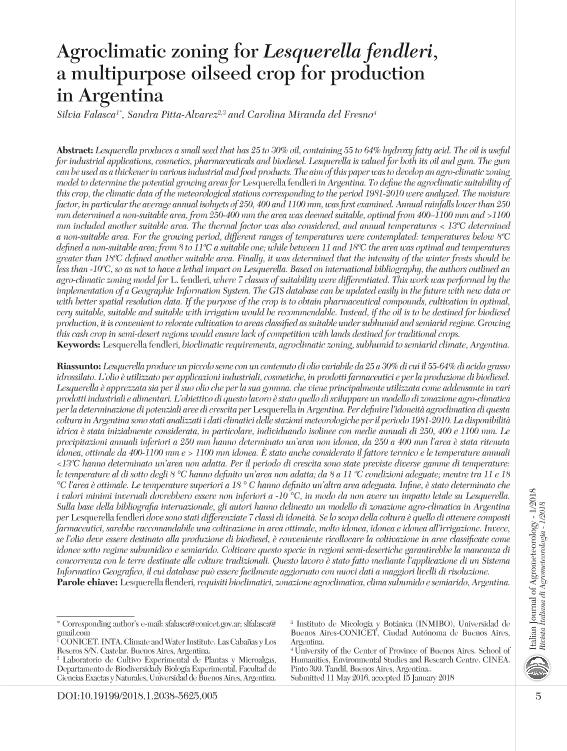Artículo
Lesquerella produces a small seed that has 25 to 30% oil, containing 55 to 64% hydroxy fatty acid. The oil is useful for industrial applications, cosmetics, pharmaceuticals and biodiesel. Lesquerella is valued for both its oil and gum. The gum can be used as a thickener in various industrial and food products. The aim of this paper was to develop an agro-climatic zoning model to determine the potential growing areas for Lesquerella fendleri in Argentina. To define the agroclimatic suitability of this crop, the climatic data of the meteorological stations corresponding to the period 1981-2010 were analyzed. The moisture factor, in particular the average annual isohyets of 250, 400 and 1100 mm, was first examined. Annual rainfalls lower than 250 mm determined a non-suitable area, from 250-400 mm the area was deemed suitable, optimal from 400–1100 mm and >1100 mm included another suitable area. The thermal factor was also considered, and annual temperatures < 13ºC determined a non-suitable area. For the growing period, different ranges of temperatures were contemplated: temperatures below 8ºC defined a non-suitable area; from 8 to 11ºC a suitable one; while between 11 and 18ºC the area was optimal and temperatures greater than 18ºC defined another suitable area. Finally, it was determined that the intensity of the winter frosts should be less than -10ºC, so as not to have a lethal impact on Lesquerella. Based on international bibliography, the authors outlined an agro-climatic zoning model for L. fendleri, where 7 classes of suitability were differentiated. This work was performed by the implementation of a Geographic Information System. The GIS database can be updated easily in the future with new data or with better spatial resolution data. If the purpose of the crop is to obtain pharmaceutical compounds, cultivation in optimal, very suitable, suitable and suitable with irrigation would be recommendable. Instead, if the oil is to be destined for biodiesel production, it is convenient to relocate cultivation to areas classified as suitable under subhumid and semiarid regime. Growing this cash crop in semi-desert regions would ensure lack of competition with lands destined for traditional crops. Lesquerella produce un piccolo seme con un contenuto di olio variabile da 25 a 30% di cui il 55-64% di acido grasso idrossilato. L’olio è utilizzato per applicazioni industriali, cosmetiche, in prodotti farmaceutici e per la produzione di biodiesel. Lesquerella è apprezzata sia per il suo olio che per la sua gomma. che viene principalmente utilizzata come addensante in vari prodotti industriali e alimentari. L’obiettivo di questo lavoro è stato quello di sviluppare un modello di zonazione agro-climatica per la determinazione di potenziali aree di crescita per Lesquerella in Argentina. Per definire l’idoneità agroclimatica di questa coltura in Argentina sono stati analizzati i dati climatici delle stazioni meteorologiche per il periodo 1981-2010. La disponibilità idrica è stata inizialmente considerata, in particolare, individuando isolinee con medie annuali di 250, 400 e 1100 mm. Le precipitazioni annuali inferiori a 250 mm hanno determinato un’area non idonea, da 250 a 400 mm l’area è stata ritenuta idonea, ottimale da 400-1100 mm e > 1100 mm idonea. È stato anche considerato il fattore termico e le temperature annuali <13 ºC hanno determinato un’area non adatta. Per il periodo di crescita sono state previste diverse gamme di temperature: le temperature al di sotto degli 8 °C hanno definito un’area non adatta; da 8 a 11 ºC condizioni adeguate; mentre tra 11 e 18 °C l’area è ottimale. Le temperature superiori a 18 ° C hanno definito un’altra area adeguata. Infine, è stato determinato che i valori minimi invernali dovrebbero essere non inferiori a -10 °C, in modo da non avere un impatto letale su Lesquerella. Sulla base della bibliografia internazionale, gli autori hanno delineato un modello di zonazione agro-climatica in Argentina per Lesquerella fendleri dove sono stati differenziate 7 classi di idoneità. Se lo scopo della coltura è quello di ottenere composti farmaceutici, sarebbe raccomandabile una coltivazione in area ottimale, molto idonea, idonea e idonea all’irrigazione. Invece, se l’olio deve essere destinato alla produzione di biodiesel, è conveniente ricollocare la coltivazione in aree classificate come idonee sotto regime subumidico e semiarido. Coltivare questo specie in regioni semi-desertiche garantirebbe la mancanza di concorrenza con le terre destinate alle colture tradizionali. Questo lavoro è stato fatto mediante l’applicazione di un Sistema Informativo Geografico, il cui database può essere facilmente aggiornato con nuovi dati a maggiori livelli di risoluzione.
Agroclimatic zoning for Lesquerella fendleri, a multipurpose oilseed crop for production in Argentina
Fecha de publicación:
05/2018
Editorial:
Patron Editore
Revista:
Italian Journal of Agrometeorology
ISSN:
2038-5625
Idioma:
Inglés
Tipo de recurso:
Artículo publicado
Clasificación temática:
Resumen
Archivos asociados
Licencia
Identificadores
Colecciones
Articulos(INMIBO (EX - PROPLAME))
Articulos de INSTITUTO DE MICOLOGIA Y BOTANICA
Articulos de INSTITUTO DE MICOLOGIA Y BOTANICA
Citación
Falasca, Silvia Liliana; Pitta Alvarez, Sandra Irene; Miranda del Fresno, Ma. Carolina; Agroclimatic zoning for Lesquerella fendleri, a multipurpose oilseed crop for production in Argentina; Patron Editore; Italian Journal of Agrometeorology; 2018; 1; 5-2018; 5-14
Compartir
Altmétricas




